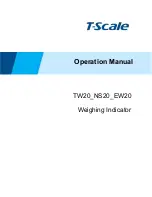
OPERATIONAL GUIDE
TAKING MEASUREMENTS
• Turn the meter on by connecting the 12 Vdc power
adapter to the meter and to the mains.
• Immerse the probe in the solu-
tion, making sure that the metal
pins are completely submerged.
• The LCD will show the EC or TDS
value. Any initial variation may
be due to temperature compensa-
tion and the fact that the probe
is adjusting itself to the new
sample. Allow the reading to sta-
bilize and the meter will start
continuous monitoring.
ADJUSTING THE SETPOINT
These meters allow you to select the desired setpoint value
and be alerted by a visual alarm (red LED) when an
abnormal situation arises.
• To access the MEASURE/SET switch, unscrew and remove
the rear panel and gasket. Then move the switch to the
left (SET Mode).
• With a small screwdriver adjust the
setpoint trimmer to display the de-
sired setpoint (within the specified
range; see Specifications table).
•
Move back the switch to the right (MEASURE Mode).
• Close the meter with the rear panel, while making sure
the gasket is in place before tightening the screws.
• Whenever the reading varies from
the setpoint more than the hyster-
esis specified for your model, the
red alarm LED will blink.
PROBE MAINTENANCE
To minimize clogging and provide longer life for the probe,
it is recommended to clean it often or at least once a month.
• Immerse the tip of the probe in
HI 7061
Cleaning
Solution for one hour.
• If a more thorough cleaning is required, brush the
metal pins with very fine sandpaper.
• After cleaning or when not in use, rinse the probe with
tap water.
Note
:
HI 983304
is supposed to be used for pure water
applications and, therefore, probe cleaning is not
required.
For the greatest accuracy, frequent calibration of the instru-
ment is recommended.
• Turn the meter on and make sure
that the MEASURE/SET switch is on
the MEASURE position.
• Pour a small quantity of the proper
calibration solution in a beaker. If
possible, use plastic beakers to mini-
mize any EMC interference.
Use the 1413 µS/cm solution at
HI 983303
, 1382
ppm for
HI 983306
, 5.00 mS/cm for
HI 983307
, or
6.44 ppt for
HI 983308
.
• Immerse the probe in the solution,
making sure that the metal pins
are completely submerged.
Note:
In order not to affect the accuracy of measurements,
it is important that the probe body does not touch
nor stand close to the side walls of the beaker.
• Wait for a couple of minutes for thermal equilibrium to
be reached, then tap the probe gently on the bottom,
then shake it, to make sure no air bubbles have
remained trapped.
CALIBRATION
• With the supplied screwdriver, adjust the calibration trim-
mer until the display shows the calibration solution value:
1410 µS (
HI 983303
), 1380 ppm (
HI 983306
), 5.00
mS (
HI 983307
) or 6.44 ppt (
HI 983308
).
• The calibration is now complete and the instrument is
ready for use.
The instrument should be recalibrated at least once a
month and after performing probe cleaning procedure.
Note
:
HI 983304
is supposed to be used for pure water
applications and, therefore, does not need calibra-
tion.
ACCESSORIES
HI 7631/2*
Flow-thru conductivity probe with ½” NPT
thread, ATC & 2 m (6.6’) cable (
HI 983304
)
HI 7632/2*
Flow-thru conductivity probe with ½” NPT
thread, ATC & 2 m (6.6’) cable (
HI 983307/8
)
HI 7634/2*
Flow-thru conductivity probe with ½” NPT
thread, ATC & 2 m (6.6’) cable (
HI 983303/6
)
HI 70031P
1413 µS/cm calibration solution, 20 mL sachet
(25 pcs)
HI 70032P
1382 ppm calibration solution, 20 mL sachet
(25 pcs)
HI 70038P
6.44 ppt calibration solution, 20 mL sachet
(25 pcs)
HI 70039P
5.00 mS/cm calibration solution, 20 mL sachet
(25 pcs)
HI 70031L
1413 µS/cm calibration solution, 500 mL bottle
HI 7039L
5.00 mS/cm calibration solution, 500 mL bottle
HI 7061L
Probe cleaning solution, 500 mL bottle
HI 710005
12 Vdc power adapter, US plug
HI 710006
12 Vdc power adapter, European plug
HI 710012
12 Vdc power adapter, Australian plug
HI 710013
12 Vdc power adapter, Southern Africa plug
HI 710014
12 Vdc power adapter, UK plug
* To be replaced by authorized technical personnel only
CE DECLARATION OF CONFORMITY
Recommendations for Users
Before using these products, make sure that they are entirely suitable
for the environment in which they are used. Operation of these instru-
ments in residential areas could cause unacceptable interferences to
radio and TV equipment.
The metal band at the end of the probe is sensitive to electrostatic
discharges. Avoid touching this metal band at all times. During opera-
tion, ESD wrist straps should be worn to avoid possible damage to the
probe by electrostatic discharges.
Any variation introduced by the user to the supplied equipment may
degrade the instrument’s EMC performance.
To avoid electrical shock, do not use these instruments when voltages at
the measurement surface exceed 24 Vac or 60 Vdc.
Use plastic beakers to minimize any EMC interferences.
To avoid damages or burns, do not perform any measurement in micro-
wave ovens.
IST9833R3 05/05




















